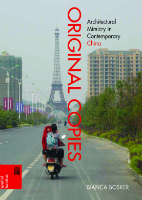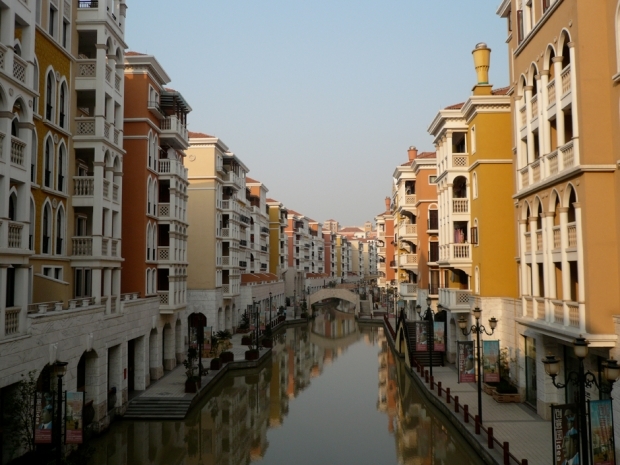One of the most striking features about daily life in China is how much of what one encounters has been appropriated from elsewhere. It’s not just the fake iPhones or luxury watches—pirated consumer goods are common in many developing countries. In many Chinese cities, foreign ideas and concepts are constantly being used to shape the external reality, from clothes and pop music to contemporary art and film. As The New York Times reported this week, there is even a smartphone CEO who consciously models himself on Steve Jobs.
Above all are the physical spaces. All over China, planners are busy emptying the countryside of people, leveling villages, and replacing the small-plot agriculture that defined rural parts of the country for millennia with American-style industrial agriculture. Urban areas, meanwhile, have lost most of their distinctive characteristics. Even in cities known for their beauty, uniformity rules: in Hangzhou, the entire waterfront along the Grand Canal has been leveled except for one stone bridge. The rest is now apartment blocks and bars. Cities like Wuxi are even worse; the old city has been eradicated in favor of an industrial park aesthetic wedded to 1950s-style American automobile culture, with everything planned around highways, shopping malls, and subdivisions.
New architecture, when it is notable, is nearly always by foreigners or copying foreign styles, a tendency that has led Western architects to flood into China, often with second-rate projects for sale. When some sort of indigenous style is attempted, as for example the now de rigeur recreation of one or two old streets, it is usually an attempt to evoke an idealized past rather than adhere to a particular historical idiom.
What drives this obsession with foreign styles? Bianca Bosker gives some answers in her fascinating new book, Original Copies: Architectural Mimicry in Contemporary China. Bosker focuses on the suburbs for the upper class that began to be built in the late 1990s, following the privatization of real estate. These are not just individual buildings but entire streetscapes, with cobblestone alleys, faux churches (often used as concert halls), towers, and landscaping designed to reproduce the feel of European and North American cities. The city of Huizhou features a replica of the Austrian village of Hallstatt; while Hangzhou, a city famous for its own waterfront culture, now includes a “Venice Water Town” that has Italian-style buildings, canals, and gondolas. Other cities in China now feature Dutch colonial-style townhouses, German row houses, and Spanish-style developments.
Books
04.23.13

Original Copies
Original Copies is filled with analysis about why these developments flourish. One reason, Bosker argues, is that replicas are highly valued in Chinese culture—copies and mimicry of the innovations of others do not carry any negative connotations. In small doses, this idea has some validity. Great Chinese painting or calligraphy masters typically used to pattern their work on those who went before, only creating distinctive works later in their career. But it’s too glib to say that the sort of second-rate reproductions being built in Chinese cities have ever been accepted in Chinese or Asian culture. Copying was an homage, done at a high level, and a precursor to true creation. One thinks, perhaps, of how Japanese jazzophiles curated and reissued classic American LPs that had gone out of production in the 1970s. These were made to the highest standards and implied true connoisseurship, rather than a superficial understanding of the genre.
This is quite different from the subdivisions, which use some expensive accoutrements (Italian marble, French chandeliers, American carpets) as selling points, but which are instantly recognizable as poor imitations. As Bosker notes, the buildings disregard the original proportions in order to emphasize the monumental size of some features, such as towers or clocks—a cartoonish vision. (Fascinatingly, almost all of the suburbs Bosker studies are designed by Chinese architects for wealthy Chinese clients; some foreign architects were tried but they represented their home countries as they saw them, not in the historical pastiche that the developers wanted for their clients.) This is hardly in the spirit of another traditional Chinese cultural practice—of copies that change the original but keep its essence. Instead we have the West as marketing gimmick.
Indeed, Bosker’s most convincing explanation for the developments is economics: Chinese tend to identify their culture with decline—old buildings call to mind China’s poverty and backwardness, not its glory; whereas achieving Western standards of living has been held up as a primary goal of modernization. So for developers, copying foreign towns became one way to gain cachet and jack up the price, especially as the new rich in China were beginning to travel abroad more widely and gain familiarity with these styles.
One wonders if this is different from what has happened with the newly affluent in other parts of the world. Qatar boasts an artificial island with a series of housing developments meant to evoke European architecture. And one only has to think of the tacky architecture that abounds in the United States: J. Paul Getty’s replica of a Vesuvian Roman Villa, the Hearst Castle, or even Abbot Kinney’s “Venice of America” in Los Angeles.
A larger difficulty with trying to identify some essential Chinese attitudes at play in this kind of mimicry is that the people who live in such developments are hardly ordinary Chinese. (Bosker introduces us to one resident, a former ping pong star who has flashcards of famous automobiles that he’s training his son to recognize. She explains this by quoting from Umberto Eco’s Travels in Hyperreality: “Baroque rhetoric, eclectic frenzy, and compulsive imitation prevail where wealth has no history.”) As a result, these developments offer little insight into the overall situation of urban planning in even the wealthiest cities, such as Beijing, Shanghai, and Guangzhou, let alone in the scores of second- and third-tier cities, such as Shijiazhuang, Jinan, Xuzhou, Wuxi, Hefei, and Bengbu. Most of the developments in these places are architectural nightmares, built by technocrats who want to warehouse tens of millions of peasants who have been kicked off their land.
As for their future, many of these architectural fancies—unlike the originals on which they are modeled—already seem dated, part of the go-go first decade of the twenty-first century when rich Chinese had serious money for the first time and were trying to figure out how to spend it. As in other countries that went through similar phases—one thinks especially of Taiwan—slavish imitation of foreign things eventually gives way to an appreciation of national culture. Bosker has a final chapter on the rise of Chinese-style gated communities, which make use of domestic architectural motifs like stone pathways lined with bamboo and slate roofs meant to evoke traditional building methods.
Does this signify a rise of creativity and a change in how China looks? It’s possible. Certainly China has creative architects, such as the Pritzker Prize winner Wang Shu, who is known for recycling destroyed Chinese buildings—especially tiles and wooden beams—in his own edgy structures. In the past, when China wanted showpiece buildings it turned to foreigners. Now architects like Wang are getting some commissions.
It’s not clear, however, whether creative minds like Wang represent China’s future, or are an avant-garde enclave educated and feted in the West. Part of the reason that fakes have an appeal in China is that the country lacks cultural self-confidence. China’s leaders want to turn the country into a cultural superpower but they still manage intellectual life too tightly to allow for the free flow of ideas that would require.




